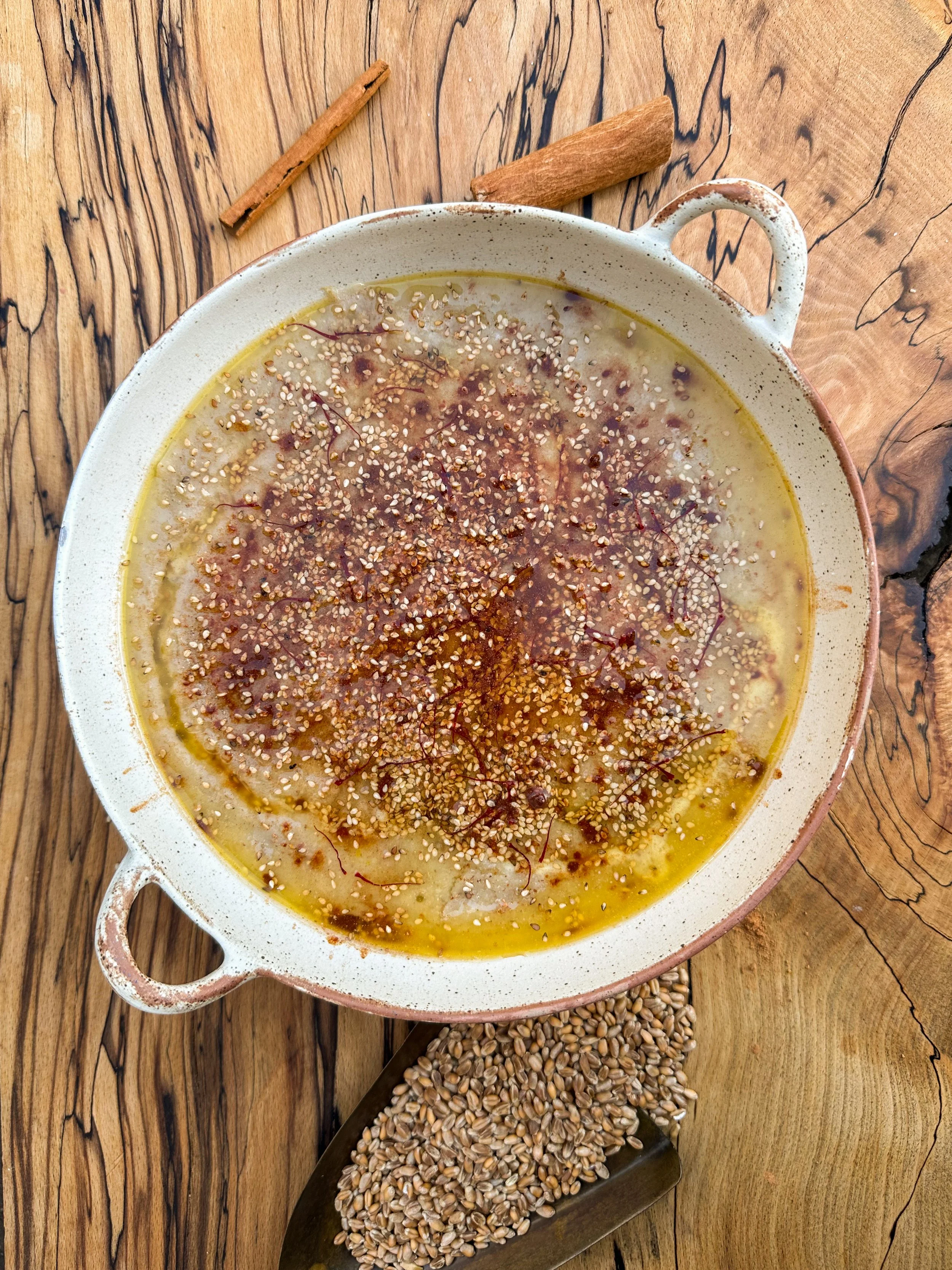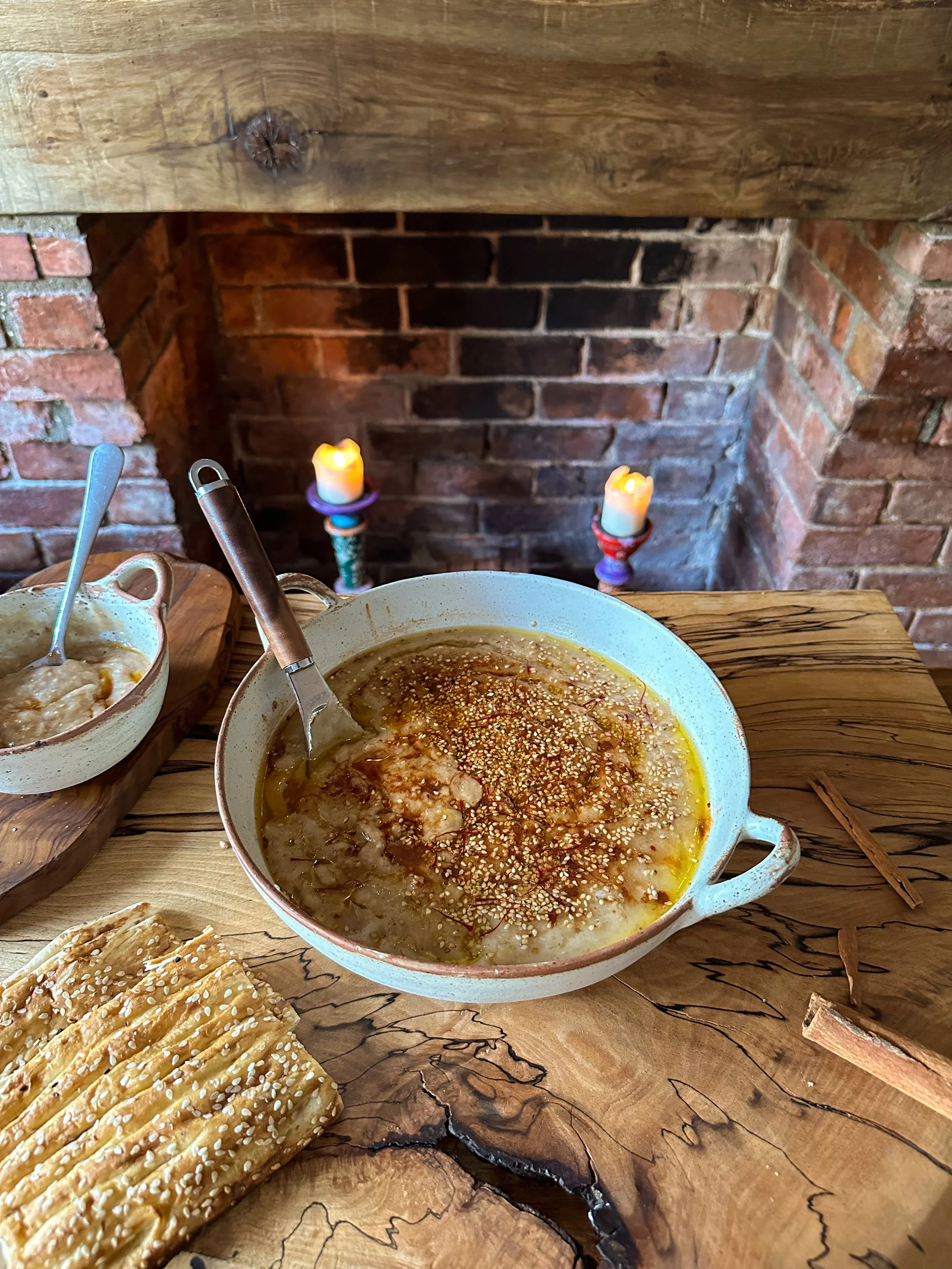Halim-e Gandom - Persian Haleem
Haleem is a popular dish in Middle Eastern and South Asian cuisine, including countries like Pakistan, India, Bangladesh, and Iran. It typically consists of meat (such as beef, lamb, chicken or turkey) and grains like wheat or barley. Slow-cooked to a thick, porridge-like consistency, it's enjoyed during Ramadan for its filling nature.
Persian Halim is a variation that is popular in Iran. It is made mainly from wheat and meat, cooked until creamy. It's served with toppings like cinnamon, sugar, and fried onions for special occasions. It's also a popular choice for breakfast and has different variations across different cities in Iran.
In my childhood memories, Fridays were extra special. My dad would wake up early to bring home delicious treats like Halim, Kalepacheh, and freshly baked bread like Noon Barbari or Noon Sangak. When we woke up the table was already set, and we gathered around eagerly. With the radio playing our favourite comedy show, "Sobhe Jome Ba Shoma" (Friday Morning with you) we laughed and enjoyed our breakfast together. These moments were about more than just the tasty food; they were about the joy of being together as a family.
Creating Haleem is a labour of love, requiring patience and dedication. I recommend breaking it down over two days to make the process more manageable. This approach allows you to fully appreciate each step without feeling overwhelmed. While it may take time, the result is undoubtedly worth the effort. I used unpeeled wheat, which made cooking the wheat and extracting the wheat milk more time-consuming. You can speed up the process by using pelted wheat.
You can also make extra and freeze it in portion-sized freezer bags. The rich flavours and comforting texture of homemade Haleem are unmatched, making it a culinary journey well worth embarking on.
Here is a short video of the cooking process on my Instagram.
Cook the most popular Persian dishes at home with the help of my e-book.
Time
Soaking: overnight Prep: 10 Cook: 6h Total: 6h 10min
Ingredients (serving 8)
700g wheat, soaked in water overnight (Use pelted wheat to speed up the process)
500g lamb neck fillet, cut in half + beef or lamb bone with marrow (optional)
3.5l water
1 medium onion, roughly sliced
1 tbsp ghee
8 tbsp / 120g butter
1 cinnamon stick
Sesame seeds to garnish
Cinnamon powder to garnish
Saffron threads to garnish (optional)
Sugar to serve
Bread of choice to serve
Salt to taste
Method of preparing Haleem
Cook the wheat
Rinse the wheat that was soaked in water overnight and transfer it to a large pot. Add 3l of water and bring it to a boil. Skim off any foam from the surface. Reduce the heat, close the lid and let it simmer up to for 4 hours until the wheat grains are soft. Stir occasionally.
Add more freshly boiled water, if needed.
Cook the lamb neck
Meanwhile, heat 1 tbsp ghee in a pan and sauté the sliced onion for about 5 minutes.
Add the lamb neck to the pan with the onion, along with the cinnamon stick and bone with marrow if you have one.
Add 500ml freshly boiled water to the pan and salt to taste.
Put on the lid and let the meat cook for 2 to 3 hours. Add more boiled water if needed.
Once the meat is perfectly tender, remove it from the pan and pull it apart with two forks.
For a creamier, stickier result you can also mash the meat to break it down further. Set it aside for later.
Pour the content of the pan through a strainer, catching the cooking liquid. Add the bone marrow to it. Set it aside.
Prepare the wheat mixture
Once the wheat grains are cooked soft, drain them in a colander, catching the cooking water. It will have a thick, starchy consistency now.
Blend the cooked wheat in a food processor, adding some of the cooking water and regular, warm water to achieve an oatmeal-like consistency. If you can’t fit all the wheat in your blender, process it in batches.
Poor the mixture through a strainer, catching the wheat milk in a pot. Stir the mixture in the strainer to extract as much wheat milk as possible.
Transfer the squeezed wheat back to the food processor and blend it with some cooking water and warm water again. Then strain it again and stir the mixture in the strainer to get as much wheat milk out of it as possible. Repeat these steps a third time to get the most out of the wheat.
Discard the remaining wheat bran.
Cooking the Halim
Bring the thick wheat milk to a boil, then reduce the heat to low and let it simmer for about 2 hours, stirring regularly.
Add 3 tbsp butter, the mashed meat, the cooking liquid of the meat and salt to taste.
Keep stirring until you achieve a thickening to a porridge-like consistency.
Serving
Transfer the Halim to a serving bowl. Melt the remaining butter and pour it over the Halim. Garnish with sesame seeds, cinnamon powder and saffron threads if you like. In Iran, we eat Halim sweet. You can combine it with a few teaspoons of sugar and enjoy it with Naan Barbari or Sangak or your favourite bread.
I’d love to see your Haleem! Feel free to tag me with @igotitfrommymaman on Facebook or Instagram so I can take a look and give you a thumbs up!
Want to save this recipe for later? You can pin it to your recipe board.
Looking for more Persian recipes? Here are more of my free written recipes!
Sign up to Maman’s recipe mail for notifications of new recipes on the blog and special offers on my courses.
Thanks for stopping by! Let’s stay in touch via Instagram, Facebook or Pinterest.

